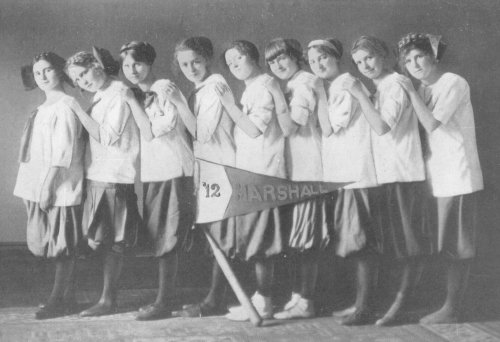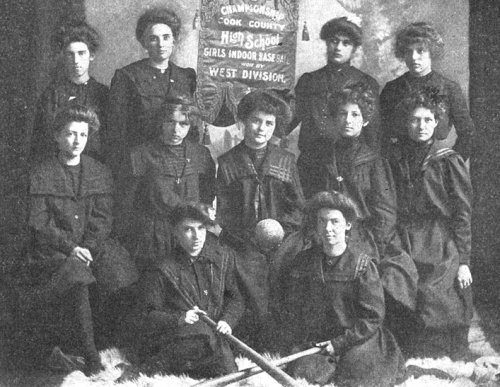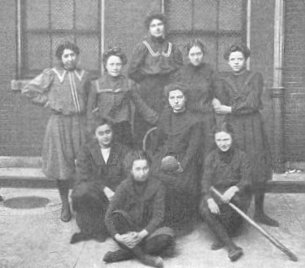History of Girls "Softball" Before IHSA Sponsorship
By ROBERT PRUTER
Softball had a long history in women sports before 1976, when the Illinois High School Association sponsored the first state tournament in girls softball at Mineral Springs Park in Pekin. Richton Park (Rich South) won that championship. The sport grew tremendously in the years that followed, splitting up into two classes in 1985 and into three classes in 2007.
The softball played by Illinois high school girls in the twenty-first century looks nothing like the game played by high school girls in earlier eras. For one, the ball at 12-inches in circumference is much smaller, and the game is close to baseball with the fast pitch and with the speed and athleticism in which it is played. In contrast, for much of the history of girls softball prior to the 1970s the game was slow pitch and used balls 14-inch to 17-inch in circumference.
The game, in fact, was not even called softball for the first thirty years of its existence. It was called indoor baseball, and was invented by George Hancock in 1887 at the Farragut Boat Club on Chicago's South Side. He and his friends bundled an old baseball glove into a ball and made a game of baseball with it. A set of rules were quickly written up and indoor baseball spread like wildfire through Chicago during the 1890s. Before long high school girls began experimenting with the game.
The basic equipment was a huge 17-inch ball and a stick-like bat. No gloves were worn, and the catcher wore no mask. The ball was truly soft—the rules called for it to be made of a "yielding substance"-far from the hardness of the softball of today. The distance between bases was greatly reduced from baseball, being only 27 feet apart. The pitcher was a mere 22 feet from home plate. Sandbags served as bases, and players were allowed to slide into them and push them along in the slide. The game involved nine players, with two shortstops, left and right, and only two outfielders, left and right.
The city's West Side was particularly notable as a hotbed for the sport, and as early as 1895 West Division had a girls team. The girls team was sponsored and coached by a teacher at the school, Milo S. Walker, who made himself a national advocate for women's participation in the game in various publications such as the Spalding guides. For edification of readers elsewhere in the nation he reported in an essay for the Spalding Indoor Baseball Guide:
"Indoor baseball has been played by the young women of the West Division and Joseph Medill High Schools of Chicago in their gymnasiums during the last five years. The first team was organized in the West Division High School in 1895, but there was no attempt to coach the team for [there was no] competition with other schools at all until the winter of 1899. The game is steadily gaining in favor among the young ladies of the various high schools of Chicago."
In 1901 a formal league was organized for indoor baseball. Reported the Chicago Tribune, "A departure was made in high school athletics yesterday afternoon, when it was decided at a meeting of managers of the girls indoor baseball teams to form a league. The teams represented in the new league, all from the West Side, are from John Marshall, Joseph Medill, and West Division. Teams have been formed at different times among the girls in these schools, but they always disbanded for the want of interest and lack of opponents." The teams played a round-robin schedule. The games went unreported in the papers, except for one story in mid-April by the Tribune, on a game between West Division and Medill. The victory by the West Division girls, said the paper, "gives them the title of champions of the Cook County League."
West Division, 1903
Medill, 1903
The 1900-01 season would be the only season that there would be a girls league. The next season West Division talked up resumption of the league in the school's newspaper, and cited its benefits: "Indoor baseball is certainly a suitable game for the majority of girls. It is not rough and unlike basketball, it does not require very great strength and endurance. Instead of these it requires quickness and self-control. For these reason it would certainly be beneficial to any who became interested in it." But Medill and Marshall refused to resume their participation, as West Division complained in January, "The prospects of forming a girls' indoor league are not very bright. Most of the other schools, especially Medill and John Marshall, are disinclined to form a league. They fear W.D.'s team outclasses them too much."
The end of indoor baseball as an interscholastic activity for girls reduced it to a sporadic intramural sport, just as the boys' game was taking off. On occasion a team would try to arrange a game with another school, and in 1912 there was a flurry of interscholastic activity, when the Phillips girls arranged a series of matches with other city schools, notably Marshall and Hyde Park. The Marshall game in early February launched Phillips' schedule and the Chicago Tribune thought the game worthy of a by-line and headline. The reporter noted that the game was the first indoor baseball game played in "several years" by high school girls teams. The contest was played under boys' rules. In tune to the changing times, however, the school authorities insisted that the game be a "closed affair," with no audience, not even female fans.

Marshall, 1912
Up to shortly after World War I, indoor baseball for girls continued as an intramural sport, but not in any formal or consistent manner. Schools would adopt and then drop indoor baseball depending on the interest at the time. In 1915, McKinley (formerly West Division) was still the most prominent promoter of indoor baseball for girls, and decided to abandon basketball to play indoor baseball instead. They made an attempt to play other schools, but none could be found. Hyde Park on the South Side that year was fielding intramural teams, but its activity in the sport apparently went unnoticed by McKinley. The 1916 McKinley yearbook reported that its team played "two outside" games, but gave no more specifics. The Hyde Park 1916 yearbook did not report on girls indoor baseball, but the 1917 yearbook reported on a girls' intramural program.
The intramural game thrived after World War I, as Girls Athletic Associations were formed throughout the Chicago public school system. There were occasional isolated instances in the Chicago area where a high school competed in an outside game. In mid-May of 1917, for example, the girls of Palatine High played again against the girls team of the Sinai Social Center in Chicago.
During the 1920s the game was played both indoors and outdoors. The thin bats and 17-inch balls were usually employed, but given that the rules for the outside version allowed for a smaller ball, 14-inch to 17-inch, the girls might have used a smaller ball. In either case, the game was always referred to as "baseball" in school publications, not playground ball, not kitten ball, and of course not softball, as the term had not yet been coined. By 1925, indoor baseball was ranked as the most popular intramural sport in the city's public high schools, attracting 569 teams and 7,069 participants.
Many of the girls on these intramural teams probably played in the many park, church, and YMCA teams that were popular throughout the city. While playing in their class teams in high school they probably yearned to play other schools or amateur teams. However, the Chicago Public High School League barred outside contests for girls, other than in swimming, golf, and tennis. Some schools, however, appeared to ignore the rule or at least were unaware of the rules. In 1924 and 1925, the Parker High girls baseball team played an outdoor game annually against the Chicago Teachers College girls, and actually beat them the first year. The girls of Harrison High on the West Side in both 1925 and 1926 played outdoor games with the Corkery Playground girls.
After the 1926 season, the Chicago school authorities ended interscholastic contests in the sponsored sports, and clamped down on all other interscholastic contests, which had been heretofore overlooked. That put an end to the annual contests by the Harrison and Parker girls. However, in 1930 the Schurz girls began an annual series with the North Shore Country Day school. That first year the game was scheduled to be played outdoors, but a rain forced the game indoors, which indicates that the girls were probably playing with a 17-inch ball. The Schurz team beat the academy girls 29 to 5. The series was ended after the 1934 game, when school authorities again took notice of increased illegal interscholastic activity in the high schools and again barred all such contests.
For the next several decades, softball continued to be played in girls physical education classes, but indoor baseball had disappeared by the end of the 1920s, and so the game was usually played outdoors in the spring. At the same time, the city was filled with park and playground teams, Catholic Youth Organization teams, industrial league teams, church teams, amateur club teams, and even semi-pro teams. Many high school-aged girls were playing softball in competition, but not for their high schools.
The opening up of girls high school sports to interscholastic competition began to change in the late 1960s, when the IHSA began allowing interschool competition in certain individual sports. Then dramatic changes began in 1972, with the passage by Congress that year of the piece of legislation known informally as Title IX, which required colleges and high schools to offer equal opportunity for both sexes in all programs, including sports. The IHSA responded vigorously, and within a few years the girls were served with a full panoply of sports all year round, including softball. Several years of competition that quickly spread through high schools around the state preceded the inauguration of the state tournament in 1976.
Published with permission. All rights are reserved by the author.
The opinions expressed in this article are those of the author and not necessarily those of the Illinois High School Association.

